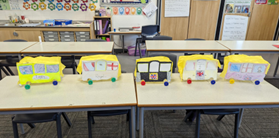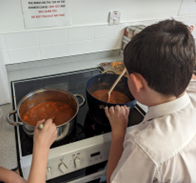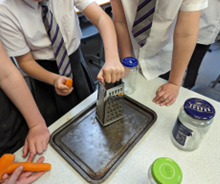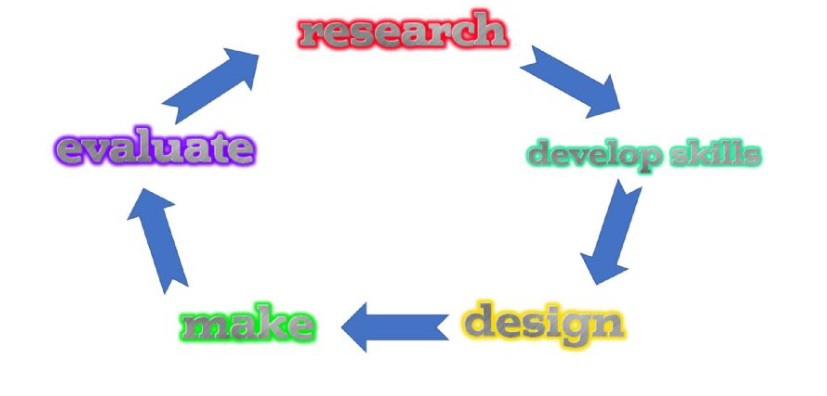Design & Technology
 Design & Technology Curriculum Intent:
Design & Technology Curriculum Intent:
Nurture: Through Design and Technology, children are nurtured by being given the opportunities to explore, develop and refine their ideas. They will learn resilience through having opportunities to work as group, consider others' viewpoints and collaborate ideas when designing. Children will learn to select the appropriate tools and resources to fit a purpose.
Curiosity: Curiosity is a key part in children being successful designers. Their exploration of a range of media and materials allows them to build upon their creativity and imagination. By being inquisitive learners, they will be able to explore their thoughts and ideas in depth to help them discover how things work and apply this knowledge to develop their own plans.
Diversity: Using the history of technology, researching a diverse range of significant individuals and valuing others' viewpoints will allow children to better understand how things are made to fit a purpose.
Ambition: Children are encouraged to be ambitious in their DT designs and then to use the evaluation process to support them in how to make it better next time. This will enable them to participate successfully in an increasingly technological world.
Implementation
The Design and technology national curriculum outlines the three main stages of the design process: design, make and evaluate. Each stage of the design process is underpinned by technical knowledge which encompasses the contextual, historical, and technical understanding required for each strand. Cooking and nutrition* has a separate section, with a focus on specific principles, skills and techniques in food, including where food comes from, diet and seasonality.
The National curriculum organises the Design and technology attainment targets under five subheadings or strands:
- Design
- Make
- Evaluate
- Technical knowledge
- Cooking and nutrition*
Kapow Primary’s Design and technology scheme has a clear progression of skills and knowledge within these five strands across each year group.
Pupils respond to design briefs and scenarios that require consideration of the needs of others, developing their skills in six key areas:
- Mechanisms
- Structures
- Textiles
- Cooking and nutrition (Food)
- Electrical systems (KS2) and
- Digital world (KS2)

Each of the key areas follows the design process (design, make and evaluate) and has a particular theme and focus from the technical knowledge or cooking and nutrition section of the curriculum. The Kapow Primary scheme is a spiral curriculum, with key areas revisited again and again with increasing complexity, allowing pupils to revisit and build on their previous learning.
Lessons incorporate a range of teaching strategies from independent tasks, paired and group work including practical hands-on, computer-based and inventive tasks. This variety means that lessons are engaging and appeal to those with a variety of learning styles. Differentiated guidance is available for every lesson to ensure that lessons can be accessed by all pupils and opportunities to stretch pupils’ learning are available when required. Knowledge organisers for each unit support pupils in building a foundation of factual knowledge by encouraging recall of key facts and vocabulary.
Impact is constantly monitored through both formative and summative assessment opportunities. Furthermore, each unit has a unit quiz and knowledge catcher which can be used at the start and/ or end of the unit.
Pupils should leave school equipped with a range of skills to enable them to succeed in their secondary education and be innovative and resourceful members of society.

Impact
The expected impact of following the Kapow Primary Design and technology scheme of work is that children will:
- Understand the functional and aesthetic properties of a range of materials and resources.
- Understand how to use and combine tools to carry out different processes for shaping, decorating, and manufacturing products.
- Build and apply a repertoire of skills, knowledge and understanding to produce high quality, innovative outcomes, including models, prototypes, CAD, and products to fulfil the needs of users, clients, and scenarios.
- Understand and apply the principles of healthy eating, diets, and recipes, including key processes, food groups and cooking equipment.
- Have an appreciation for key individuals, inventions, and events in history and of today that impact our world.
- Recognise where our decisions can impact the wider world in terms of community, social and environmental issues.
- Self-evaluate and reflect on learning at different stages and identify areas to improve.
- Meet the end of key stage expectations outlined in the National curriculum for Design and technology.
- Meet the end of key stage expectations outlined in the National curriculum for Computing.

Design and Technology education involves two important elements – learning about the designed and made world and how things work, and learning to design and make functional products for particular purposes and users.
In Design and Technology, children acquire and apply knowledge and understanding of materials and components, mechanisms and control systems, structures, existing products, quality and health and safety.
Children are encouraged to be creative and innovative, and are actively encouraged to think about important issues such as sustainability and enterprise.
The design process for every product:

![]()

